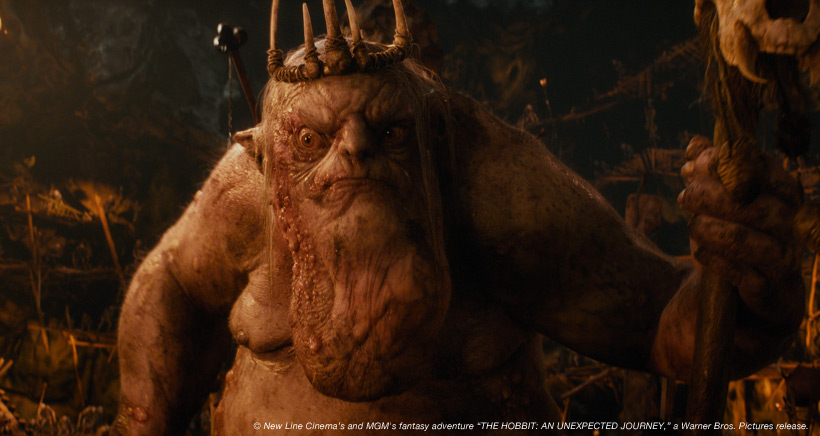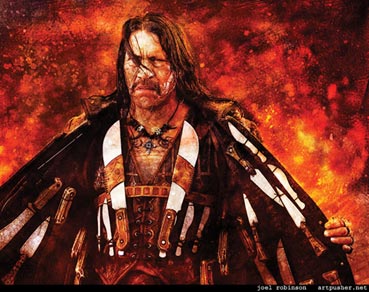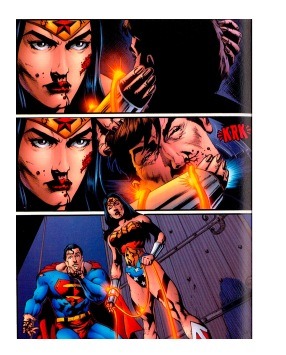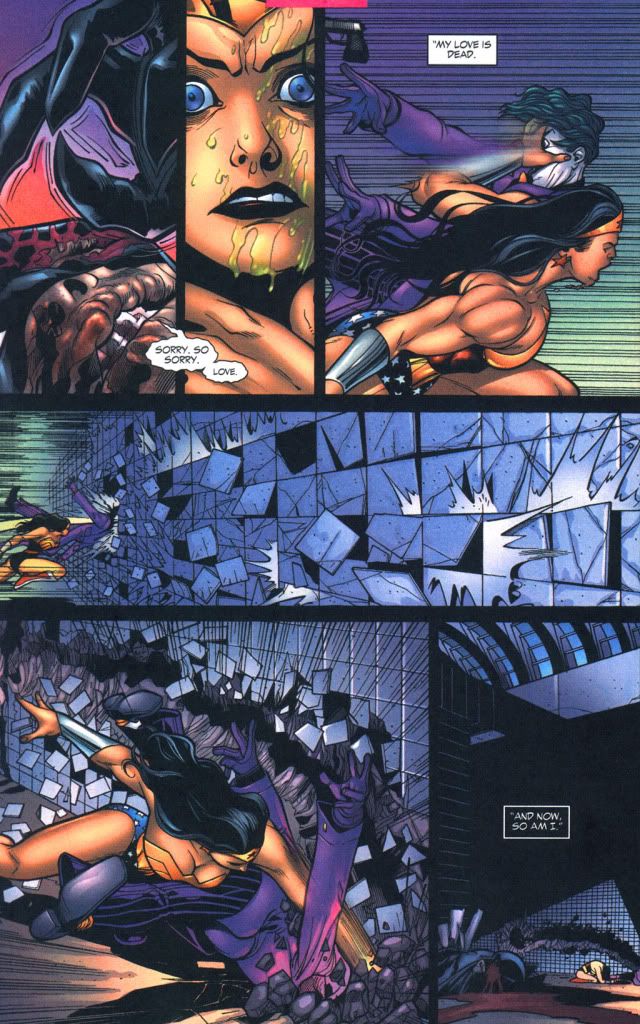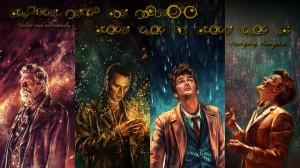I’m a fan of DC Comics until the end of days. No getting around that. My first formative comics-reading experience, or at least the earliest one I remember, was Crisis on Infinite Earths, featuring every character in DC’s stable. I didn’t follow the Avengers or the X-Men, I read Justice League. I liked Batman, Superman, and even Blue Beetle and Booster Gold far more than Spider-man or Captain America.
Today I’m less exclusive. I read my fair share of Marvel books, just way, way less than DC. I’d still rather read an okay comic about Superman than a great comic about Wolverine.
Which is why it breaks my heart that when it comes to movies and other adaptations, Warner Bros. is getting their ass kicked so hard by Marvel Studios.
Let me explain. It’s not the success of Marvel Studios that bothers me. Well, not most days. There is a certain internet geek pundit who I shan’t name or link to who is so obsessed with slagging everything DC does, inventing flaws if necessary, while championing every single thing that Marvel Studios does, ignoring flaws as often as he has to, that I felt this weird need to resent Marvel properties to balance him out. But that is not healthy, and it’s why I’m giving up his videos and articles. Because I can’t stop him from being rigidly and unflinchingly biased (if you honestly think Agents of SHIELD is a better show than Arrow, you’re just wrong), but I can stop myself from sinking into the same swamp.
So, no, it’s not that I resent Marvel movies doing well. Super excited to see both Captain America: Winter Soldier and Guardians of the Galaxy. What kills me is that Warner Bros. is not keeping up. And when they do try and exploit DC’s properties, you just have to ask… are you even trying?
At the movies
I liked Man of Steel and I’m not sorry. As such, I refuse to be pessimistic about the upcoming sequel featuring Ben Affleck as Batman, especially since it means the next Batman movie won’t be an origin story. And if they do, in fact, try to follow that up with a Flash movie leading into Justice League, I am all for it. Hell, there’s still time to get Darkseid into a movie before Thanos finally makes a proper appearance in Avengers 3.
That sounded like slagging Marvel but it’s just that Thanos is a knockoff of Darkseid (no, really, look it up), and I’d rather people not claim it’s the opposite just because Thanos made it into a movie first. That’s all.
For decades now, Warner Bros. has been coasting on Batman. Since 1989, there have been eight theatrically-released movies about Batman, ranging from incredible (The Dark Knight) to great (Batman Begins, Mask of the Phantasm) to pretty okay (Batman, The Dark Knight Rises) to crimes against cinema (Batman and Robin). In the same 24 year time frame, there have only been two good-but-not-great Superman movies, one movie for Green Lantern that could charitably be called a misfire, and Shaquille O’Neal as Steel. I’m sure I don’t need to elaborate on that one.
No I do not count Catwoman. That movie has as much to do with the comic character Catwoman as the Karate Kid movies had to do with the Legion of Superheroes. Same name, no other connection or similarity.
Now consider what Marvel managed to do in half that time. Since just 2008, Marvel Studios alone has cranked out three Iron Man movies, two for Thor, one for Captain America (with another in the wings), one for the Hulk, and their crown jewel, the Avengers. And these range in quality from amaze-balls (Avengers) to merely mediocre (Iron Man 2, Thor), with most achieving a rank of “actually pretty damn good.” Throw in the characters they sold to other studios before forming their own, and in only 13 years we’ve had four movies for Spider-man and the X-Men, two for Ghost Rider, the Fantastic Four, Wolverine, and the Punisher, one for Daredevil, a spin-off for Elektra and another for Hulk. Now, these range in quality a bit more drastically, from great (Spiderman 2, X-2) to pretty bad (most of them) to downright excruciating (Ang Lee’s Hulk), so quantity doesn’t assure quality.
But in terms of numbers, Warner Bros. can’t really compete: Marvel Studios exists to crank out Marvel properties, whereas DC Entertainment is but a part of the larger Warner Bros. empire, which has other things going on and can’t commit to the same mass-production. But here’s my real problem.
By 2014, there will have been eight movies for Batman, six for Superman, three for Blade, and two movies starring freaking Ghost Rider, but zero movies starring Wonder Woman. The greatest female super-hero of all time, the third member of DC’s Big Three, and Rocket Raccoon is going to be in a movie before she is. Nobody at Warner Bros. should be proud of this, and whoever fired Joss Whedon when he was trying to write a movie for her should be banned from movie-making forever.
Maybe Warner Bros. can’t commit to more than one movie per year. But come on. Diana of Themyscria should be at the top of the list.
Now… the small screen.
On the teevee
I’m going to focus on DC’s shows here, because that’s my main point. Suffice to say I’m intrigued to see the four shows Marvel sold to Netflix and I sure hope Agents of SHIELD gets better.
Now, here is an area where DC is at least competitive. Sure, Birds of Prey tanked pretty hard, but Smallville lasted ten seasons and as many as six of them were pretty watchable*.
And now we have Arrow, which started out surprisingly good and is growing into the first truly great superhero show in a generation. In their second season, Arrow has made Oliver Queen an amazing and conflicted protagonist, given him a great supporting cast (even Thea Queen, season one’s weak link, has improved dramatically), and is doing unparalleled work at building the comic-based universe around its central characters.
Unparalleled. Looking at you, Agents of SHIELD. (Sorry, sorry, back to my point)
So between the cult hit of Arrow and the hype and moderate success surrounding Agents of SHIELD, it’s only natural that more shows based around superheroes start turning up. Given that comic books are a medium based around serial storytelling, TV has always been a better fit; 22 episodes a year allows for much better long-term storytelling than one movie every two to four years. So let’s see what DC has in the pipeline, shall we?
The Flash
Thus far, the Arrow-verse has held the line on super powers. Nobody has them. That’s set to change when Barry Allen makes his debut for the mid-season finale, leading to a planned Flash spin-off series next year. And I’m excited. Because while the showrunners did fail at producing a good Green Lantern movie, Arrow’s been knocking it out of the park this year, so I trust them to replicate that success with the Flash. Hey, I was a huge fan of the first Flash TV series, which actually holds up better than I thought it would.
My only qualm is that they’re making this Flash series at the same time that they’re prepping a Flash movie, and if they’re not connected? If Warner Bros. officially splits their movie universe apart from the TV universe while Marvel is maintaining one continuity across all of their endeavors? That’s worse than a missed opportunity. That’s grade-A dumb.
So here’s hoping that they do the smart thing and use Flash to link up Man of Steel and the Arrow-verse. I just wish that hope weren’t so fleeting.
Gotham
And now we hit grade-A stupid full-on.
Gotham is a rumoured pilot for the Fox network about Jim Gordon’s early police career in a pre-Batman Gotham City.
Does everyone see why this is a terrible idea? Do I need to go on? Well, the fact that this might be a real thing means someone doesn’t see the massive flaws, so I’ll elaborate.
First off. Splitting your properties across multiple networks is just throwing up barriers to building a shared universe, something that, once again, Marvel has proven works like gangbusters. It will be easy to do Arrow/Flash crossovers, since they’ll both be on the CW, but Fox isn’t known for playing well with others.
Second. It took Smallville several years to start having other proto-versions of DC’s heroes turn up, but it was always a big success. They got a massive ratings spike from having Aquaman show up, of all people. Adding Green Arrow to the cast salvaged the back half of the series. They added Flash (well, sort of), Cyborg, Hawkman, Stargirl, Doctor Fate, the Legion of Superheroes, even Booster Gold and Blue Beetle.
Notice a name missing from that list? Because the fans sure did.
Smallville was basically forbidden to use Bruce Wayne/Batman at any point. Rumour has it they brought in Green Arrow, ultimately making him a regular, because there was a role they wanted young Bruce Wayne to play in shaping Clark’s path but weren’t allowed to use him. Warner Bros. made the baffling decision to isolate Batman from everything else they were doing. Okay, sure, the larger DC universe wouldn’t have fit in Christopher Nolan’s Batman movies, but I don’t see why that means Bruce Wayne couldn’t be on Smallville. And now Arrow is name-dropping Ra’s Al Ghul and rumours are flying that Nightwing will turn up, but again no mention of Batman.
And that is bad enough. Banning Batman from Smallville and Arrow is already a dumb move, but banning him from a series starring one of his supporting cast? A series set in Gotham but with no Batman? Who thinks there’s an audience for that? You want to replicate Agents of SHIELD? Fine. I get that. But there’s already a perfect template for that, and it was called Gotham Central. Gotham Central had a rich and fascinating cast of police detectives trying to solve crimes in a city where the drug dealer you’re planning to bust might turn out to be Mr. Freeze. Most importantly, a series where Batman was never a regular player, but did turn up from time to time. That is the Gotham-based cop show I would watch. The adventures of Jim Gordon before Batman began? No. No thank you. I watched Clark Kent refuse to become Superman for ten goddamn years, I’m not doing it again.
Constantine
Meanwhile, NBC is looking to develop a show based around John Constantine, the magician/con man who has grown from a linchpin of DC’s mature-readers Vertigo line to a key figure in the magical portion of DC’s main product line. As a solo operator or the defacto leader of the Justice League Dark, he takes on demons, monsters, and other magicians to maintain the balance and protect the world, but is generally a bastard about it and tends to get the people closest to him killed. He was already turned into a not-terrible movie starring Keanu Reeves, but is ripe for re-adaption. And possibly this time they’ll let him stay British.
I have two problems with this. First, again, being on a different network means that any Constantine show will again risk being a stand-alone, when all I want is for DC to embrace the shared universe as rabidly as Marvel has. Second, why haven’t they cast Mark Sheppard as Constantine yet? Sure, he’s not young anymore, but he’s a British actor who specializes in playing bastards you can’t help but love in geek-friendly shows. He’s a perfect fit, dagnabbit.
Hourman
Hourman was one of DC’s earliest characters, a chemist named Rex Tyler who developed a pill called Miraclo that gave him super-strength, speed and invulnerability for one hour. Sort of like a super-soldier serum you have to keep taking. There have been other attempts to make characters named Hourman, but the one that stood the test of time is, basically, the first superhero drug addict.
Seriously, the most interesting thing they’ve done with Hourman in the last twenty years is have Dr. Mid-nite, his JSA teammate who is also a physician, constantly berate him about how he’s clearly addicted to Miraclo and how unhealthy that is.
Not that any of this would be in the proposed TV series. No, they’re borrowing a much lesser-known power from a much lesser-known version of the character, the ability to see one hour into the future. Skipping over the costumed adventurer whose powers come from a troubling source, skipping over the time-travelling android from the far future trying to learn to be human, and focusing on the most obscure Hourman-related ability they could find.
Mm-hm.
Is it even a superhero show at this point? Because it feels like an utterly generic “protagonist must stop a tragedy before it happens” show. Early Edition with a tighter deadline. I’m not convinced they’d even give him a costume.
Wrapping up
So. While Marvel is building their universe through more Avengers movies and their ultra-ambitious Defenders project on Netflix, DC looks to be splitting up their universe more and more with redundant Flashes, unnecessary prequels, and farming their characters out to different studios, the exact strategy that is limiting Marvel to their B and C-list characters, because they sold their A-list to Sony and Fox.
And through all of this, nothing for Wonder Woman. If you’re desperate enough to turn to Hourman of all people, you should be desperate enough to finally make a Wonder Woman project that’s any good.
I want to see a DC cinematic universe. I do not want to continue to see DC characters existing in independent bubbles, with no crossing over allowed. Unless, of course, this is all building to the Netflix miniseries Crisis on Infinite Earths, in which Smallville, the Nolan-verse, Arrow-verse, and various other movie and TV universes collide… man, I’d watch the shit out of that. Shame that isn’t happening. Great. Somehow I’ve managed to depress myself even more.
But this is why you hurt me, Warner Bros. It’s not because Marvel is beating you. It’s because it doesn’t even seem like you’re stepping up to the plate. Please, do better.
*Not a recommendation. I stand by my policy of never officially recommending Smallville. Watch it if you want, but that’s your decision. I cannot guarantee your safety, nor will I be responsible for your fate.
